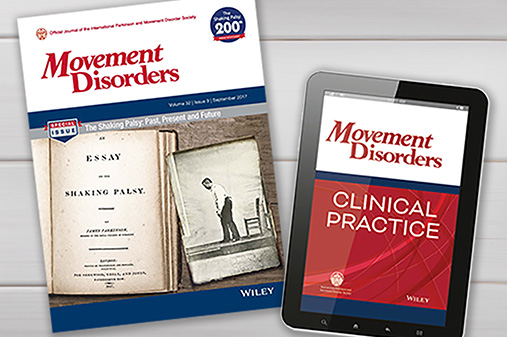Hot Topic: Normal pressure hydrocephalus - Clinical aspects and differential diagnosis
Dr. Sara Schaefer: Hello and welcome to the MDS Podcast, the official podcast of the International Parkinson and Movement Disorder Society. I'm your host, Sara Schaeffer from the Yale School of Medicine and the Deputy Editor of this podcast. And today we're going to be doing our first interview in our Hot Topic series on normal pressure hydrocephalus.
I have the pleasure of talking to Dr. Mats Tullberg, who's a professor of neurology and senior consultant neurologist and chief of the Adult Hydrocephalus Research Group and Hydrocephalus Care program at the University of Gothenburg and Sahlgrenska University Hospital in Sweden. Thank you so much for joining us today.
View complete transcript
Dr. Mats Tullberg: Thank you so much for having me.
Dr. Sara Schaefer: So in this first episode, we're gonna talk about the clinical aspects and differential diagnosis of NPH, and in later episodes we're gonna talk [00:01:00] about potential pathophysiology behind NPH and also how to work up NPH and treat it.
So we'll start with just the clinical aspects of NPH. We are taught in medical school, the NPH triad, right? Encephalopathy, gait dysfunction and urinary incontinence. But that's a little bit of a simplistic explanation for how NPH may present. Can you just talk about the characteristic features of NPH and also how they evolve over time?
Dr. Mats Tullberg: Yes and N PH, and I would like to start by also introducing the aspect of the types of NPH. We have secondary NPH, which are caused by for instance, subarachnoid hemorrhage. And we have the idiopathic form, which is the most common form, and that form that most elderly are affected by, but NPH is characterized [00:02:00] by a clinical syndrome. That is how we look at it today. And the triad is a little bit simplistic, as you said but it's still true. So from the beginning in the mid sixties when NPH was first described, the triad of gait disturbance, dementia and urinary incontinence was stated. Research has developed that knowledge a little bit and we now consider gait and balance disturbance the core or central parts of the clinical syndrome.
So you should include balance disturbance too. Moreover the encephalopathy or cognitive deterioration or disturbance that is characteristics is also more specified of course today. And we consider it subcortical cognitive impairment, just like the subcortical vascular disease or cognitive [00:03:00] impairment.
Which has similar features. The urinary incontinence is also specific. It's a central bladder dysfunction, uninhibited bladder with urge and developing incontinence. And you can also have both urinary and bowel incontinence in severe cases. What is also evident is that we have a general motor impairment, just like in the movement disorders.
So it's not only the gait, it's not only lower body parkinsonism as it has been called but you also see disturbance of movements in hands, upper limbs. So you have a general hypokinesia and we use tests for hand motor function in our clinical assessments just because we see those changes.
NPH is characterized by a clinical syndrome consisting [00:04:00] of a number of symptoms. The development is gradual. It usually starts with a gait and balance disturbance, but not in all cases, but in most cases, that's where it's all starts.
In the beginning, symptoms can be very slight and can easily be mistaken by effects of aging or some other disease. But as they develop, it's usually becomes more and more evident that this is not aging, it's something is wrong, it's a disease of some kind. So usually at start gait and balance, and then later additional cognitive impairment and urinary incontinence. So that's how it starts from the patient's perspective. They complain about gait disturbance problems of walking, slow walking. They complain about falls which is a sign that is quite characteristic for NPH. [00:05:00] They complain about the urinary incontinence, which can be very socially impaired function. And from the neurologist perspective, you should look for these features and you can distinguish, the typical features of NPH and characterize this as a clinical syndrome of NPH, and that's one of the messages I am very keen on bringing forward to movement disorder specialists because it is important that we identify these patients.
Dr. Sara Schaefer: So I wanna get into some of the nitty gritty of what you might ask on history or see on exam that might help you tease apart NPH from some other things. You talked about slowness, right? Which obviously could be mistaken for parkinsonism or Parkinson's disease. We hear about the magnetic gait of NPH, what is that?
What does that look like? And also with the urinary [00:06:00] issues. Does urine dynamic testing help you differentiate this from other things? Do they have elevated post void residuals with retention or is it more an overactive bladder with urgent incontinence that you see with a normal PVR?
Dr. Mats Tullberg: If we start with a urinary problem the later description is the correct one. It's an overactive bladder problem. So it starts with frequent voiding urge. As soon as the, a patient has feels the need to urge, they have to go to the toilet in order to stay continent and as it develops, the bladder starts eliminating out of control and the urinary incontinence can be total continence. So it's not an increased residual volume that is not the kind, and it's all also not the stress incontinence type that women may suffer from. It's an urge incontinence, just like neurogenic [00:07:00] bladder incontinence.
You can have in other disorders like in spinal disorders, et cetera. So that's the type. You can diagnose it by regular urological tests. Boris ice water test, for instance, or measurements that assess the ability of the bladder to keep urine without the voiding. Usually the history is characteristic and the important thing for the neurologist is to carefully listen to the patient and how the patient and relatives describe the development.
Because if it's from the beginning, it is an urge problem then you should feel confident that this is the type of incontinence that is connected with NPH and not something else. But of course you need to be open for also coexisting prostate problems in males and stress incontinence in women.
So you may have a mixed [00:08:00] incontinence and then you may need assistance with evaluation by a gynecologist or a urologist in order to assess what is what.
If we move on to the other symptoms, if we talk about gait and balance problems and start with the gait as you said, there is a typical disturbance that you see in many, but not all patients where you have the broad-based shuffling gait the magnetic gait where patients do not lift their feet above the floor. There is difficulty in turning, using many steps to turn 180 degrees. Usually you can differ that gait disturbance in NPH from the typical extra pyramidal gait disturbance of parkinsonisms, but not in all cases because there are also cases maybe around one third of the patients do not have the broad [00:09:00] based or shuffling gait.
So you need to be a little open. But if you see that gait disturbance, for the trained clinician you can distinguish that. Patients usually use their arms to assist their gait. It's not like in Parkinson disease where the arms are kept next to the body without movement.
In NPH, you may have increased arm movement while walking. For the balance, in some patients the balance disturbance is dominating and in others, it's the gait disturbance that is dominating. The typical balanced disturbance in NPH is a retropulsion, a tendency to fall backwards just like you may see in PSP for instance, but not in all cases.
But when we see that together with a broad-based shuffling gait, very slow gait, short step. Then that is also a sign that makes us [00:10:00] identify NPH patients. You may see gait arrest in NPH, which makes it a little more difficult than p arkinsonism. And that is also one message that is important that there are overlap in the clinical syndrome that makes it both very interesting but also difficult. In some patients y ou see both signs of parkinsonisms, and NPH, and it may be that the NPH clinical syndrome may contain traits of parkinsonism or extra pyramidal signs. Or that the other possibility that you have a patient, you face a patient with a comorbid NPH plus Parkinson's disease, for instance, and that's when it really gets interesting and challenging.
Dr. Sara Schaefer: And we're gonna be talking to Dr. Fasano in the next episode of this Hot topic series about copathology and [00:11:00] how that throws a wrench into things a little bit here. You've talked about some of the things that you do and look for and ask in order to try to tease out the wheat from the shaft.
If you will we've all, as clinicians gotten consults for rule out NPH, somebody got a CAT scan for some other reason and they have ventricle size out of proportion to degree of atrophy or, something non-specific like that. What are your steps when you see a patient in your clinic?
For a rule out NPH diagnosis and how do you try to separate the tease out, the wheat from the shaft, I said?
Dr. Mats Tullberg: That's a very good question. What you need, you base the diagnosis. Now we have clinical guidelines that we use and they are being updated at the moment. So we will have new international guidelines within short, but basically you should rely on a very thorough clinical [00:12:00] examination plus neuroimaging.
And if we start with a clinical examination, you should really use your neurological examination plus you include a number of tests that help you assess the specific signs, walking tests, balance tests. You look at features, of course, the classical features of parkinsonisms.
But also NPH signs, like the retropulsion, the balance disturbance. There is a sign paratonia or paratonic rigidity, which is typical of NPH. Which is different from the rigidity with cogwheel signs in parkinsonisms that you can use. So the neurologist or dedicated physician should do a thorough examination.
I also advocate, and in our center we [00:13:00] use physiotherapists that are trained that is extremely helpful and that helps you rely on the clinical picture in your diagnosis. So with a thorough physiotherapy examination with more in detail, examined balance and gait rigidity, et cetera, that helps a lot.
Of course we also see the, cognitive impairments and those should be assessed in some way. In our center, we use neuropsychologists who do a neuropsychology examination with interview and a battery of tests that is developed to capture cognitive impairments typical of NPH. So with those three, the physician, the neurologist, the physiotherapist, and cognitive testing by, for instance, a neuropsychologist. Then [00:14:00] you may capture the typical clinical symptoms.
Dr. Sara Schaefer: It's so interesting, the little tidbits, like the increased arm swing as opposed to decreased arm swing, like you mentioned, paratonia as opposed to rigidity, which, I think of as more as a frontal or frontal subcortical sign, which makes sense. Do patients with NPH in their slowness of movement have decrements of speed and amplitude the way that Parkinson's patients don't, or are they just generally slow?
Dr. Mats Tullberg: They are generally slow. There may be single cases, but we say that if you see decrements, you should think about a comorbid parkinsonism instead. And of course assess that specifically and treat it. By using a handful of clinical signs the trained eye can identify. I've been working in this field for over 30 years, and you can identify the typical signs of NPH if you see a large [00:15:00] enough number of patients. So the other part is the radiological picture, and that's where you need a trained radiologist. And I want to say here that a lot of things have happened during the last couple of years and the description and specification of the typical features of NPH on neuroimaging, cT or MRI, has improved dramatically over the last couple of years. And this is also a reason why we are seeing an increasing number of patients for clinical workup. I'm sure in my lecture I will show data from recent epidemiological studies showing that NPH is not at all an uncommon disorder.
It's probably as prevalent as Parkinson's and even in the range of Alzheimer's disease in older people. So you should look for specific [00:16:00] radiological signs and collaborate with the neuroradiologist. And it's not only the increased ventricular size, the ventriculomegaly that is typical.
You should also look for other signs telling you that it's an active dilatation of the ventricles and not the cortical atrophy. I cannot go into detail here, but that there are a few signs that are very good. Apart from the increased ventricle size, we use the Evans index, which is very easy to measure.
You look also at the other ventricles, the third and the fourth ventricles. But you look at the sulci at the top of the brain, the convexity sulci, and if they are compressed compared to the Sylvian fissures, that's a sign that telling you that this may be an active dilatation due to a CSF dynamic disturbance.
So that's one [00:17:00] sign. We call it the dish sign, where you have the combination of the tight sulci over the vertex and the dilated Sylvian fissures. Another sign is the colossal angle, the angle of the corpus callosum on coronal slices. You should look at images to, it's easier to explain but if you have an angle, colossal angle below 90 degrees.
That also tells you that this is probably an active dilatation, namely NPH. So by including also a few more specific features, you can select patients more easily. And, there is one important aspect that needs to be raised here and that is that you may have a radiological picture that is typical of NPH, but still no development of symptoms and an [00:18:00] asymptomatic case.
And I think that when you say that you should try to find those few patients that have NPH among those referred that you may have missed patients that you should consider having NPH all the same that may develop symptoms. If you have a patient with a typical radiological picture but you don't find any typical symptoms, you should follow that up and see the patient again for development because we now know that there is a high risk of developing symptoms later.
Dr. Sara Schaefer: The preclinical NPH as as you would. Okay. Like with Parkinson's, how you have to lose about 50% of your dopaminergic neurons before clinical symptoms develop.
Dr. Mats Tullberg: Exactly. That's probably the case. And when we recently published a study we found among 70 year olds, 1.5% had a clinical NPH and 3.5 had [00:19:00] asymptomatic NPH, the preclinical stage equaling up to 5% among 70 year olds, and among those 3.5%, most of them will probably develop symptoms over the years.
Dr. Sara Schaefer: So we've talked about clinical features, we've talked about imaging features and other ancillary tests that can be performed in these patients, which leads us directly to diagnostic criteria for NPH. You mentioned that this is currently under revisions. Can you tell us about the diagnostic criteria for NPH that is currently in place and what's being altered about it? And when can we expect to hear the new criteria?
Dr. Mats Tullberg: Yes, clinical guidelines are extremely important. And in 2005, the current international guidelines were published. And they were published by researchers in America and Europe. In [00:20:00] parallel the Japanese society has had a set of guidelines and updated those guidelines.
So currently we have two sets of guidelines, the international and the Japanese. What we are doing now, and that is one thing I am involved in, is to create international global NPH guidelines that should be valid all over the world. And basically we rely on a clinical syndrome of NPH and radiological features.
Plus, extra ancillary tests, and then we have to talk about the predictive tests. We have the CSF tap test or the extended lumbar drainage test. Those have strengths. They have a high positive predictive value. So if you have a positive CSF tap test or extended lumbar drainage test, you can feel confident that this patient will improve by shunt surgery, which is a very effective [00:21:00] treatment for most patients who have this diagnosis.
But if you have a negative test, the negative predictive value is low. So you may still have a patient that improves, but in the guidelines we will have a combined flow where you use the clinical picture, the radiological science, and in many cases you need a positive predictive test in order to go to treatment. But the difference now is that we can rely more on the radiological and the clinical picture than earlier. Because we know much more if we have a very typical radiological picture and the typical clinical picture that is sufficient for patients to go take the next step to treatment and of course for diagnosis.
So I would say that we will have a better description of the clinical picture. We will have a [00:22:00] better description of the radiological picture, and those two in combination gets us further ahead, a step ahead compared to earlier guidelines, especially the international from 2005. But we still need other tests.
And the predictive tests is one group of tests. But importantly we also need to develop other tests and one area where we probably will see development within maybe five or 10 years is the use of fluid biomarkers. Because we know, and I'm talking about cerebrospinal fluid biomarkers, but also coming blood or plasma biomarkers.
This is very hot in the dementia field, the Alzheimer's field. And I am sure that we will be able to use biomarkers from blood in diagnostic procedures in NPH in the future. And there are some [00:23:00] studies showing typical patterns of proteins in the cerebrospinal fluid of NPH patients that may differentiate from other patients.
Including the movement disorder spectrum. What is also very interesting is other ways of assessing the clinical picture. For instance, 3D gait analysis or the use of mobile devices for assessing gait and balance disturbance. I think this is also a field that will develop very much within the coming years. In the movement disorder field, this is more developed than in NPH, but we would like to assess the clinical picture in more detail and not just in the specialized center during one or two days. And this may also help us improve the sensitivity of the predictive tests. Basically clinical [00:24:00] symptomatology, radiological picture, predictive tests and development of new, more specific tests.
That is probably the future of diagnosis for NPH.
Dr. Sara Schaefer: Wow. That's so interesting what you said about biomarker patterns in the CSF and even in the plasma. I would think that you would get just non-specific things like neurofilament light chain or something like that. But it's interesting that people are looking at more specific things for NPH that can differentiate from other degenerative conditions.
Dr. Mats Tullberg: The very interesting thing is that this is a reversible disorder. It's so very reversible. Still, after 30 years, I get surprised every other month. Patients who have suffered symptoms for 5, 6, 7 years improve after two, three hours after a drainage of CSF. And this is [00:25:00] something that must be reflected in the biomarker pattern.
And that is something that is so interesting to hunt and to try to describe. And we know quite a lot about what happens. We know that if you do functional imaging studies, you see a downregulation of metabolism in central parts of the brain surrounding the ventricular system. You also see a downregulation of amyloid pathology that increases again.
So it's a very interesting model for brain function and reversible dysfunction that can be turned back into normal or better functioning within short. So that is also a reason why I think we will be able to find markers that are specific for the disease, a biological marker, that is really what we would need.
And historically we suffer in the [00:26:00] NPH field from poor description of symptoms, poor description of radiological features and also a view of the disease that it is very uncommon and that is, it is not very treatable. Which I am very opposed to, to say because it's a highly treatable disorder and results are very good also in the long term for many patients.
Dr. Sara Schaefer: Alright. Thank you so much for giving us all your wisdom about NPH. I wonder if you are spurring some future NPH researchers or clinicians in our audience with your passion for the field.
We really appreciate your time.
Dr. Mats Tullberg: Thank you so much and I'm so happy to have been invited here and to talk to you, Sara. Thank you very much. [00:27:00]

Mats Tullberg, MD
University of Gothenburg and Sahlgrenska University Hospital
Gothenburg, Sweden









